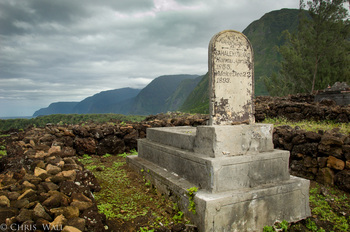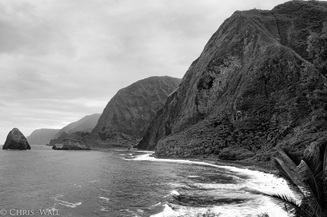
The isolated community of Kalaupapa has a long history in Hawai'i, one that is both sacred and deep in emotional and cultural connection to the people of Hawai'i. The history of Kalaupapa extends back to the ancient Hawaiians that lived in this community during a period prior to European contact. However, Kalaupapa's role in Hawaiian history is most known beginning in the 19th century during the rule of the Hawaiian Monarch. In the late 1860s Hansen's Disease (leprocy) was introduced to the Hawaiian Islands. King Kamehameha V proclaimed that people with the disease were to be forcibly sent to Kalaupapa where they would spend the rest of their days in isolation away from the their families and their community. Approximately 8,000 people died in Kalaupapa, most of which were Hawaiians. Alongside the afflicted were many members of the Catholic clergy that spent time in Kalaupapa serving and engaging with Hansen's Disease patients; some gave their lives to this cause. While there is a cure for Hansen's Disease today, patients sent to Kalaupapa still live in the settlement today. The community in Kalaupapa is very special, and thanks to the larger community of Moloka'i and the National Parks Service, the sacred past of Kalaupapa has been preserved as a part of the history and heritage of Hawai'i.


Preserving the coastal lands and beaches is a full time job, and outside of the community marine debris can be found scattered across this beautiful coastline. This may be a surprise to you considering Moloka'i has such a small population. Despite this small local population and the remoteness of Kalaupapa, debris carried to the ocean from rivers, adrift from other neighboring islands, and abandoned/derelict fishing gear have found their way to this isolated place.
I imagine the debris problem in Kalaupapa is exacerbated by two causes: (1) limited access to this area and therefore limited observation and removal of debris, and (2) the financial and logistical constraints with removing such waste from this remove stretch of the north shore of Moloka'i (i.e., there are no roads into Moloka'i: there is a donkey trail and a landing strip for single propeller planes).
It is my hope that non-governmental organizations will be able to coordinate efforts with the National Parks Service and the Kalaupapa community to establish an effective way to remediate marine debris in Kalaupapa. However, marine debris is a a global problem, amplified by our use of plastics and non-degradable materials.

So how can you aid in stopping marine debris? First, no matter where you live don't litter! This trash will eventually find its way to a water way and the ocean. Second, if you see trash, pick it up! This is effective at beaches and more terrestrial habitats. And finally, we should all work to reduce our collective reliance on plastics and non-degradable products such as plastic bags, plastic water bottles, and the like. Wherever you live, look for groups that participate in waterway/beach cleanups. These are great opportunities to learn about your local aquatic habitats and to make an impact in reducing trash on land and in the sea. Contact the Sierra Club, Surfrider Foundation, or the Ocean Conservancy to get involved.
You can learn more about marine debris from the EPA (Trash Free Waters Program) and from NOAA (Marine Debris Program), and efforts to tackle marine debris in Hawai'i (Sustainable Coastlines Hawai'i).

 RSS Feed
RSS Feed